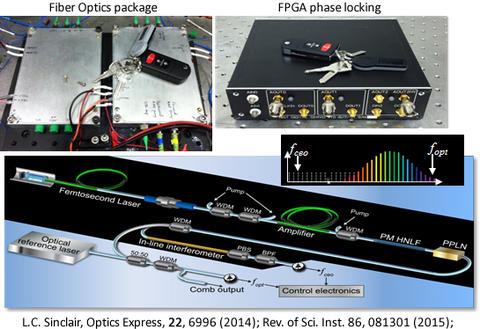Summary
To support comb-based measurements outside the metrology laboratory, we develop high performance, robust frequency combs based on fiber-optic technology.
Description

Basic fiber frequency comb design. Upper left shows the total optics package, which is the size of a laptop. Upper right shows the field programmable gate array (FPGA) digital electronics for phase locking the comb. The lower panel shows the design, which primarily uses standard fiber-optic components developed for the telecommunication industry.
Frequency combs have found a wide range of applications beyond just optical metrology. Applications include laser ranging, precision molecular spectroscopy in the lab and over the air, optical timing distribution, low-noise microwave generation and support for optical clocks. All these applications share several requirements for the underlying frequency combs. The frequency combs must be relatively low cost since multiple frequency combs are often needed. (Many systems require a minimum of two frequency comb.) They must be relatively low power and compact if they are to be realistically considered for any field applications. Finally, the frequency combs must be able to operate with high phase stability outside the metrology laboratory, over long periods of time, and under environmental perturbations. While chip scale combs may one day be a practical alternative, the current solution for fieldable combs remains fiber frequency combs with polarization-maintaining (PM) erbium (Er) fiber. The Fiber Sources and Applications Group has developed such systems with increasing levels of performance, including operation at up to 1 g of vibrations. It is now incorporated in multiple different experiments at NIST and elsewhere. Over a dozen operate routinely and continuously at NIST, including in a month-long demonstration of a femtosecond-level optical time base. Through NIST-hosted workshops and CRADAs, the basic NIST fiber frequency comb design has been transferred to the US Aerospace industry and other national laboratories. In addition, the digital-based phase-locking electronics (both hardware and firmware) are publicly available on the NIST web server. Most recently, a collaboration at NIST has developed a hybrid frequency comb design that combines a fiber-optic oscillator with supercontinuum generation in a Silicon-nitride waveguide for a low-power comb.

